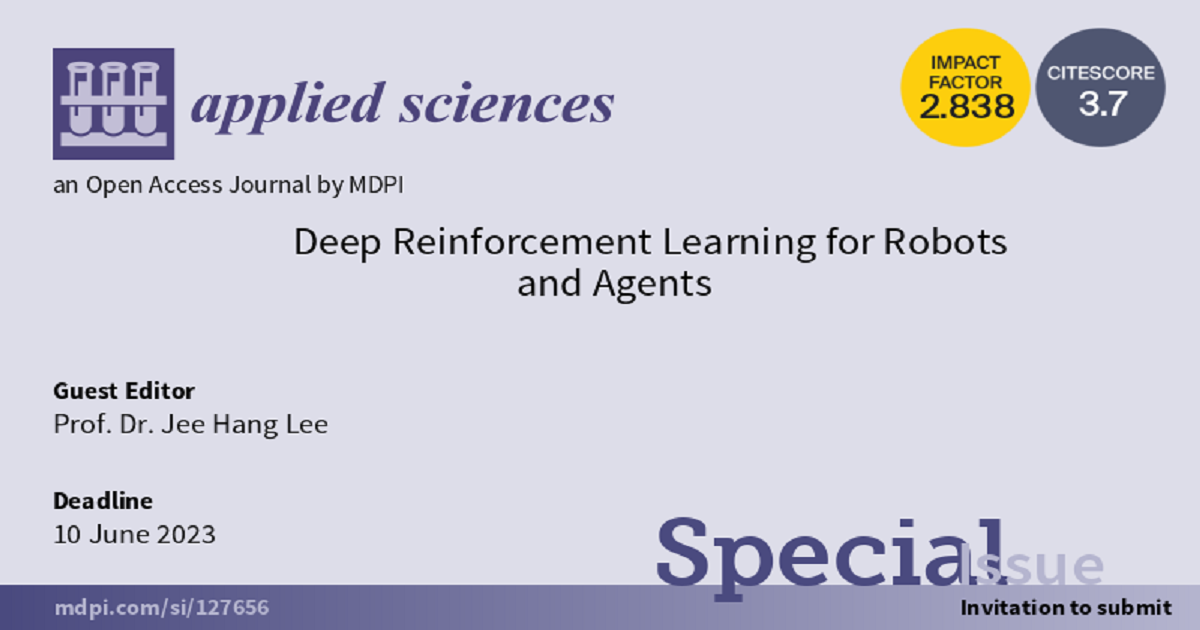Deep Reinforcement Learning for Robots and Agents
A special issue of Applied Sciences (ISSN 2076-3417). This special issue belongs to the section "Computing and Artificial Intelligence".
Deadline for manuscript submissions: closed (10 June 2023) | Viewed by 15911

Special Issue Editor
Special Issue Information
Dear Colleagues,
Coupled with the deep learning, reinforcement learning (RL) algorithms have demonstrated super-human performance in many challenging domains, ranging from games to robots, networks, energy, finance and more. Extending from this, deep RL has also exhibited remarkable advances in the domain of multi-agent reinforcement learning (MARL) in which multiple agents frequently interact to find an optimal policy to achieve a complex goal in real-world circumstances.
The main objective of the Special Issue is (i) to report the recent progress on deep RL research (in single- and multi-agent settings), (ii) to share successful examples of real-world applications utilizing deep RL agents and (iii) to address the future research issues that are crucial to escalate the state-of-the-art deep RL agents.
We thus invite paper submissions exhibiting the success of deep RL agents in the theoretical and practical domains indicated above, as well as those addressing fundamental and/or practical issues in the design of deep RL agents, including (but not limited to):
- Deep RL algorithms and architectures that cover fundamental algorithmic challenges to engineer deep RL agents;
- Successful examples in deploying applications by utilizing deep RL agents in any science and engineering domains;
- Reviews on deep RL agents overarching the holistic perspectives on the state-of-the-art algorithms and architectures; and
- Perspectives on future deep RL research delivering insights into substantial advances in the development of deep RL agents in theory and practice.
For any enquiries on this Special Issue, please do not hesitate to get in touch with us. We look forward to receiving your contributions.
Prof. Dr. Jee Hang Lee
Guest Editor
Manuscript Submission Information
Manuscripts should be submitted online at www.mdpi.com by registering and logging in to this website. Once you are registered, click here to go to the submission form. Manuscripts can be submitted until the deadline. All submissions that pass pre-check are peer-reviewed. Accepted papers will be published continuously in the journal (as soon as accepted) and will be listed together on the special issue website. Research articles, review articles as well as short communications are invited. For planned papers, a title and short abstract (about 100 words) can be sent to the Editorial Office for announcement on this website.
Submitted manuscripts should not have been published previously, nor be under consideration for publication elsewhere (except conference proceedings papers). All manuscripts are thoroughly refereed through a single-blind peer-review process. A guide for authors and other relevant information for submission of manuscripts is available on the Instructions for Authors page. Applied Sciences is an international peer-reviewed open access semimonthly journal published by MDPI.
Please visit the Instructions for Authors page before submitting a manuscript. The Article Processing Charge (APC) for publication in this open access journal is 2400 CHF (Swiss Francs). Submitted papers should be well formatted and use good English. Authors may use MDPI's English editing service prior to publication or during author revisions.
Keywords
- deep RL algorithms and architecture
- model-based and model-free RL
- MARL
- multiobjective
- on-line/off-line RL
- sample/time/space efficiency
- neuroscience of RL
- generalization
- applications
- real-world RL examples.





